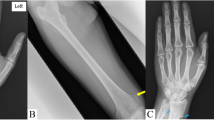Abstract
This case report of a 14-year-old boy with arthralgia and clinically suspected inflammatory arthropathy highlights how magnetic resonance imaging (MRI) ultimately diagnosed skeletal dysplasia. A genetic evaluation revealed a transient receptor potential vanilloid 4 (TRPV4) pathogenic variant. This is a rare description of the MRI appearance of this type of dysplasia in long bone epiphyses corresponding with the histological findings of disrupted endochondral ossification. This report offers imaging support to the description of endochondral bone growth disruption in TRPV4-related skeletal dysplasias.



Similar content being viewed by others
References
Orioli IM, Castilla EE, Barbosa-Neto JG (1986) The birth prevalence rates for the skeletal dysplasias. J Med Genet 23:328–332
Warman M, Cormier-Daire V, Hall C et al (2011) Nosology and classification of genetic skeletal disorders: 2010 revision. Am J Med Genet A 155A:943–968
Kang SS, Shin SH, Auh C-K, Chun J (2012) Human skeletal dysplasia caused by a constitutive activated transient receptor potential vanilloid 4 (TRPV4) cation channel mutation. Exp Mol Med 44:707–722
Nemec SF, Cohn DH, Krakow D et al (2012) The importance of conventional radiography in the mutational analysis of skeletal dysplasias (the TRPV4 mutational family). Pediatr Radiol 42:15–23
Faye E, Modaff P, Pauli R, Legare J (2019) Combined phenotypes of spondylometaphyseal dysplasia-Kozlowski type and Charcot-Marie-tooth disease type 2C secondary to a TRPV4 pathogenic variant. Mol Syndromol 10:154–160
Schindler A, Sumner C, Hoover-Fong JE (2014) TRPV4-associated disorders. In: Adam MP, Ardinger HH, Pagon RA et al (eds) GeneReviews. University of Washington, Seattle
Alanay Y, Lachman RS (2011) A review of the principles of radiological assessment of skeletal dysplasias. J Clin Res Pediatr Endocrinol 3:163–178
Laor T, Zbojniewicz AM, Eismann EA, Wall EJ (2012) Juvenile osteochondritis dissecans: is it a growth disturbance of the secondary physis of the epiphysis? AJR Am J Roentgenol 199:1121–1128
Author information
Authors and Affiliations
Corresponding author
Ethics declarations
Conflicts of interest
None
Additional information
Publisher’s note
Springer Nature remains neutral with regard to jurisdictional claims in published maps and institutional affiliations.
Rights and permissions
About this article
Cite this article
Jack, C.F., Birkemeier, K.L., Santiago, J.M. et al. Magnetic resonance imaging diagnosis of a skeletal dysplasia mimicking erosive arthropathy. Pediatr Radiol 51, 1758–1761 (2021). https://doi.org/10.1007/s00247-021-05027-6
Received:
Revised:
Accepted:
Published:
Issue Date:
DOI: https://doi.org/10.1007/s00247-021-05027-6




